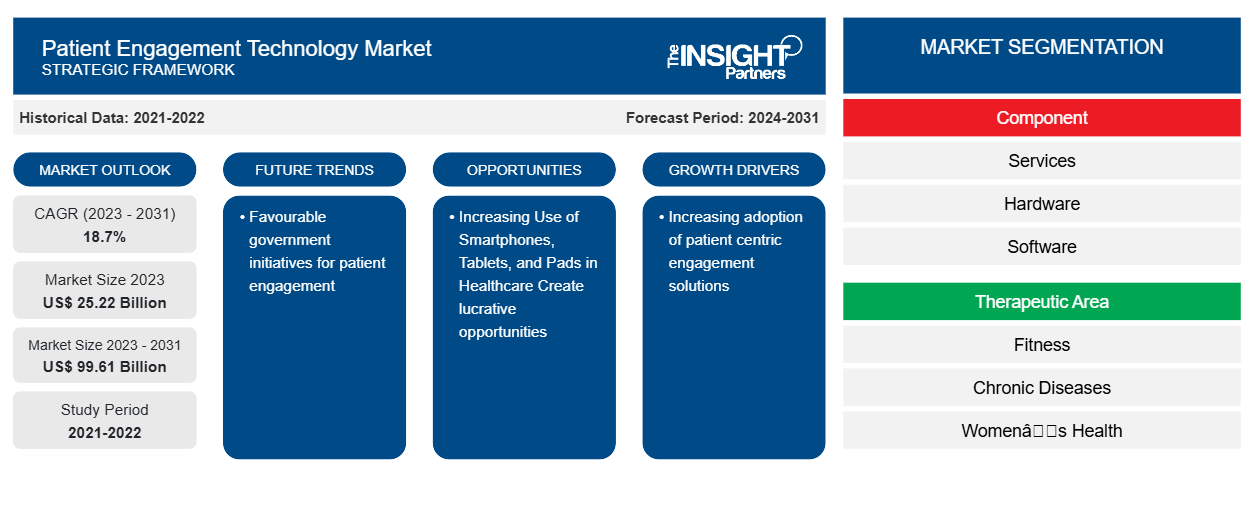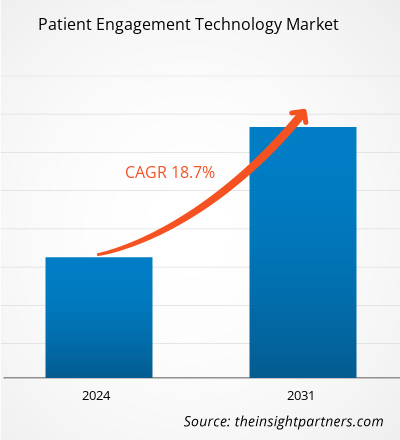The Patient engagement technology market size is projected to reach US$ 99.61 billion by 2031 from US$ 25.22 billion in 2023. The market is expected to register a CAGR of 18.7% during 2023–2031. Strategic developments by market players followed by the joint initiatives taken by the government bodies are likely to remain key trends in the market.
Patient Engagement Technology Market Analysis
Increasing adoption of patient centric engagement solutions, surging favourable government initiatives, and rising number of startups are the major factors driving the market growth. Some of the recent startups in the patient engagement technology market are Medionce Solutions, HealthCode AI, Estimtrack, and others. Moreover, increasing in product development and product launches followed by the increasing adoption of smart devoces such as smartphones, tablets, and Pads in healthcare is expected to create ample opportunities in the market.
Patient Engagement Technology Market Overview
Increasing adoption of patient centric engagement solutions, surging favourable government initiatives, and rising number of startups are the major factors driving the market growth. Moreover, increasing in product development and product launches followed by the increasing adoption of smart devices such as smartphones, tablets, and Pads in healthcare is expected to create ample opportunities in the market. North America account for the major market share owing to the increasing demand of patient engagement technology systems in hospitals and clinics in the US and increasing healthcare funding dedicated towards development of IT-based solutions for healthcare characterize the growth in North America. Asia Pacific is anticipated to register the highest growth rate owing to the increase in the investments & developments of the innovative solutions by the market leaders, increasing disposable income, rising geriatric population, and the growing demand for improved healthcare solutions.
Customize This Report To Suit Your Requirement
You will get customization on any report - free of charge - including parts of this report, or country-level analysis, Excel Data pack, as well as avail great offers and discounts for start-ups & universities
Patient Engagement Technology Market: Strategic Insights

-
Get Top Key Market Trends of this report.This FREE sample will include data analysis, ranging from market trends to estimates and forecasts.
Patient Engagement Technology Market Drivers and Opportunities
Rising Favourable Government Initiatives to Favor Market
The government in various countries is taking steps to assist in advancing information technology in healthcare. Foor instance, in February 2021, as a part of the United Kingdom government launched a program to employ a fully connected cloud-driven health service, over two million National Health Services (NHS) mail mailboxes were moved to Exchange Online, which is a part of Microsoft’s Azure Cloud. This facilitated smoother and more efficient communication among NHS organizations, and departments and increased information access. This will improve market growth by increasing the use of (Health Information Technology) HCIT Change Management services in the UK.
For instance, the 'Espace Numerique de Santé,' a digital health portal for patients set to launch in 2022, will include Dossier Medical Partagé (DMP). Patient summaries and immunization information will be added to the DMP in the future. Because of this integration, there will be no delays during the consultation because all of the data will be accessible. Such initiatives will boost the overall adoption of web-based services, resulting in the growth of the patient engagement technology market.
Increasing Use of Smartphones, Tablets, and Pads in Healthcare Create lucrative opportunities
The smartphone is one of the fastest-growing segments in the technology sector, and it has a proven significant impact on the healthcare sector. Smartphones are making day-to-day chores easier, and the technology is also streamlining care for both physicians and patients. According to a new survey, hospitals are making significant investments in smartphone and secure mobile platforms to enable communications between clinicians and patients. For example, purpose-built devices can be integrated with in-hospital patient call systems, so nurses are paged when a patient hits the call button, further increasing responsiveness.
The increasing penetration of smartphones and growing wireless network technology supports improvements in digital healthcare systems with novel opportunities to address more challenges associated with accessibility, quality, effectiveness, efficiency, and healthcare costs. Smartphones are increasingly being used by the common populace for accessing healthcare applications. The increasing use of smartphones is expected to trigger the use of mobile-based applications by healthcare providers and patients to streamline workflow and avoid inconveniences, such as hospital waiting time, availability of admission beds, and others, which will provide significant opportunities for patient engagement technology market players.
Patient Engagement Technology Market Report Segmentation Analysis
Key segments that contributed to the derivation of the Patient engagement technology market analysis are component, therapeutic area, delivery mode, application, and end user.
- Based on component, the Patient engagement technology market is divided into services, hardware, and software. The software segment held a largest market share in 2023.
- By therapeutic area, the market is segmented into fitness, chronic diseases, women’s health, and others. The chronic diseases segment held the largest share of the market in 2023.
- In terms of delivery mode, the market is bifurcated into cloud based and on-premises. The cloud based segment held a significant share of the market in 2023.
- Based on application, the market is classified into health management, financial health management, home health management, and others. The health management segment held the largest share of the market in 2023
- Based on end user, the market is segmented into patients, payers, providers, and others. The providers segment held the largest share of the market in 2023
Patient Engagement Technology Market Share Analysis by Geography
The geographic scope of the Patient engagement technology market report is mainly divided into five regions: North America, Asia Pacific, Europe, Middle East & Africa, and South & Central America.
North America has dominated the market owing to the increasing demand of patient engagement technology systems in hospitals and clinics in the US and increasing healthcare funding dedicated towards development of IT-based solutions for healthcare characterize the growth in North America. The US holds the significant share of the patient engagement technology market. The growth of the market in the country is primarily driven by increasing adoption of advanced medical device technologies, growing digitalization of medical devices, increasing emphasis on improving treatment outcomes and increasing prevalence of chronic diseases. Asia Pacific is anticipated to grow with the highest CAGR in the coming years.
Patient Engagement Technology Market Regional Insights
The regional trends and factors influencing the Patient Engagement Technology Market throughout the forecast period have been thoroughly explained by the analysts at The Insight Partners. This section also discusses Patient Engagement Technology Market segments and geography across North America, Europe, Asia Pacific, Middle East and Africa, and South and Central America.
Patient Engagement Technology Market Report Scope
| Report Attribute | Details |
|---|---|
| Market size in 2023 | US$ 25.22 Billion |
| Market Size by 2031 | US$ 99.61 Billion |
| Global CAGR (2023 - 2031) | 18.7% |
| Historical Data | 2021-2022 |
| Forecast period | 2024-2031 |
| Segments Covered |
By Component
|
| Regions and Countries Covered |
North America
|
| Market leaders and key company profiles |
|
Patient Engagement Technology Market Players Density: Understanding Its Impact on Business Dynamics
The Patient Engagement Technology Market is growing rapidly, driven by increasing end-user demand due to factors such as evolving consumer preferences, technological advancements, and greater awareness of the product's benefits. As demand rises, businesses are expanding their offerings, innovating to meet consumer needs, and capitalizing on emerging trends, which further fuels market growth.

- Get the Patient Engagement Technology Market top key players overview
Patient Engagement Technology Market News and Recent Developments
The Patient engagement technology market is evaluated by gathering qualitative and quantitative data post primary and secondary research, which includes important corporate publications, association data, and databases. A few of the developments in the Patient engagement technology market are listed below:
- Doceree launched its product named Spark at HIMSS 2024. It helps providers in enhancing the quality of care and ultimately elevating patient outcomes. Spark leverages advanced patented technology, clinical data, and AI-triggers to seamlessly deliver clinically relevant communications within existing clinical workflows, in real-time. (Source: Doceree Inc., Press Release, March 2024)
- HealthPlix launched launched Patient Engagement Feature for doctors in their EMRs. The new premium feature called Plix Connect for Doctor Patient Engagement. Plix Connect offers a range of benefits and functionalities that are aimed at enhancing patient engagement, streamlining processes, and ultimately improving the overall healthcare experience. (Source: HealthPlix Technologies, Company Website, February 2024)
- ZS, launched AI-powered ZAIDYN Connected Health solution. ZAIDYN Connected Health helps pharmaceutical companies, healthcare providers and payers innovate so they can understand unmet needs, better engage with patients and improve health outcomes. In an evolving healthcare ecosystem, it’s vital for these entities to have intelligence they can trust. (Source: ZS, Company Website, October 2023)
Patient Engagement Technology Market Report Coverage and Deliverables
The “Patient Engagement Technology Market Size and Forecast (2021–2031)” report provides a detailed analysis of the market covering below areas:
- Patient engagement technology market size and forecast at global, regional, and country levels for all the key market segments covered under the scope
- Patient engagement technology market trends as well as market dynamics such as drivers, restraints, and key opportunities
- Detailed PEST/Porter’s Five Forces and SWOT analysis
- Patient engagement technology market analysis covering key market trends, global and regional framework, major players, regulations, and recent market developments
- Industry landscape and competition analysis covering market concentration, heat map analysis, prominent players, and recent developments for the Patient engagement technology market
- Detailed company profiles
Frequently Asked Questions
Which region dominated the Patient engagement technology market in 2023?
What are the driving factors impacting the Patient engagement technology market?
What are the future trends of the Patient engagement technology market?
Which are the leading players operating in the Patient engagement technology market?
What would be the estimated value of the Patient engagement technology market by 2031?
What is the expected CAGR of the Patient engagement technology market?
- Historical Analysis (2 Years), Base Year, Forecast (7 Years) with CAGR
- PEST and SWOT Analysis
- Market Size Value / Volume - Global, Regional, Country
- Industry and Competitive Landscape
- Excel Dataset
Recent Reports
Testimonials
Reason to Buy
- Informed Decision-Making
- Understanding Market Dynamics
- Competitive Analysis
- Identifying Emerging Markets
- Customer Insights
- Market Forecasts
- Risk Mitigation
- Boosting Operational Efficiency
- Strategic Planning
- Investment Justification
- Tracking Industry Innovations
- Aligning with Regulatory Trends





















 Get Free Sample For
Get Free Sample For